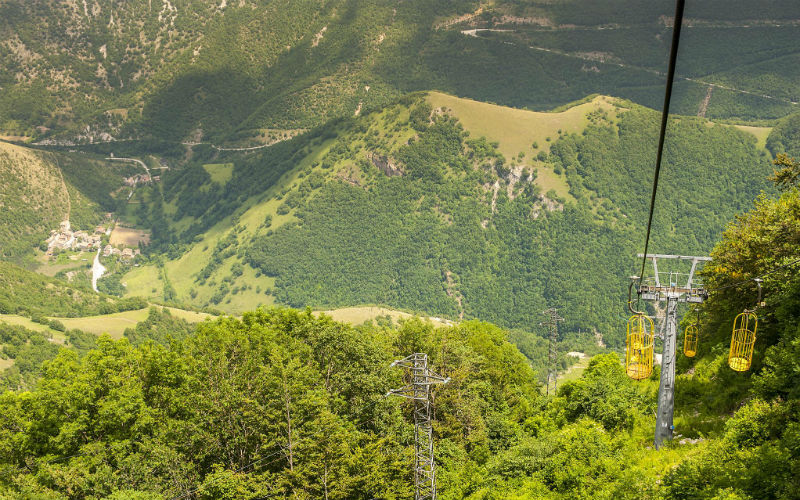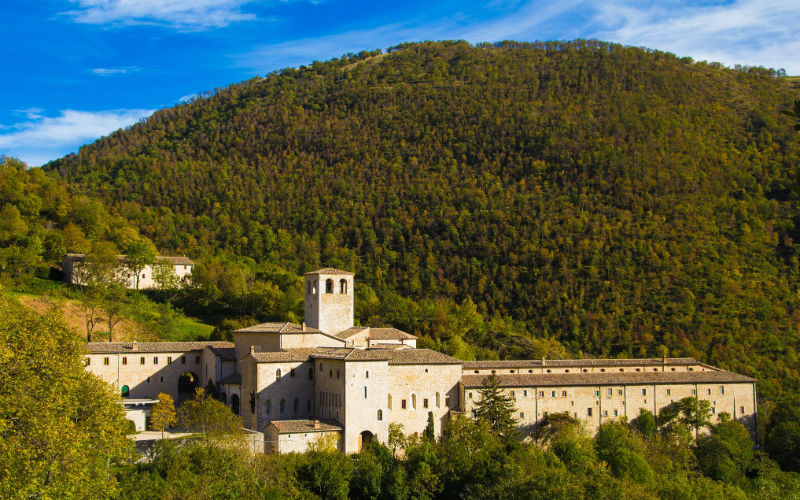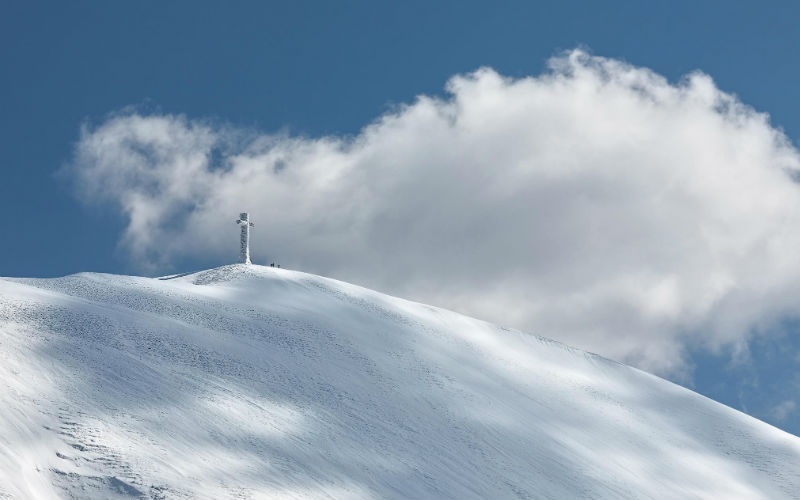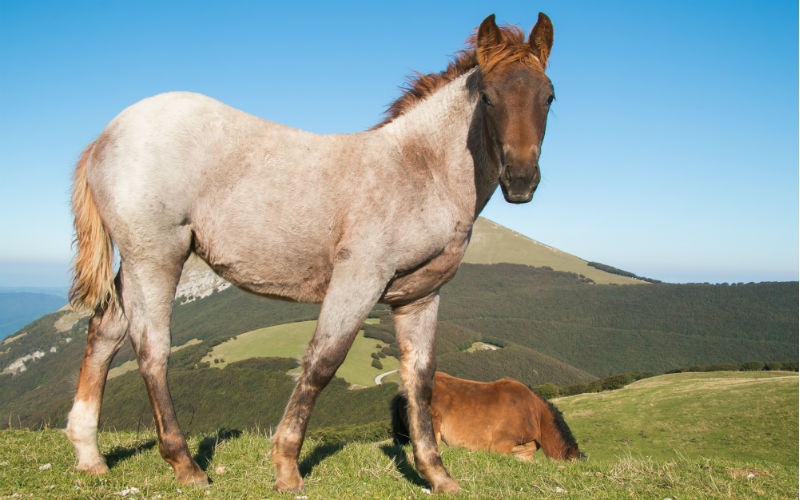Mount Catria is a typical example of an environment with great biodiversity and constitutes a complete and varied part of the Apennines. In fact, it includes meadows
, pastures, woods, torrents, gorges and imposing rocky cliff faces. A particular feature of this mountain is the presence of a number of small villages, all at the bottom of the valley at quotas not greater than 600 metres above sea level.
The thousand metres that separate the inhabited centres from the summit of Mount Catria are the site of rugged and savage nature that has prevented man from establishing a stable presence, creating a very extensive area of the range that is completely uninhabited and frequented by the local populations only for mountain activities such as grazing and the provision of wood.
These conditions enable nature to express its highest potential creating really unique and spectacular phenomenon.
The “Sacred Mountain”
Mount Catria is the highest of the Apennines in Le Marche region and every level of its 1,701 metres of altitude offers unique landscapes and experiences, that you can discover all year long.
From the Latin "cathedra" meaning the highest seat, Mount Catria owes its name to its prominent position between Mount Acuto (1,668 metres) and a gentle saddle that connects the two summits.

The ancient Via Flaminia unwinds at the foot of the mountain; the presence of the consular road is a clear sign of the fact that Mount Catria was already a geographical point of reference for the travelers of times gone by. Then there is Ponte Grosso (Large Bridge), a double-arched structure built in the 1st Century BC and located in the Burano Gorge that stands as evidence of the connection between the Adriatic Coast and the city of Rome.
Despite its less significant altitude than other summits of the Apennines, Mount Catria is a real mountain, with unexplored and almost primitive landscapes that offer different levels of hiking and rare beauty.
In the same area as Mount Catria, there is Mount Acuto, the summit of the Balze degli Spicchi, the Corno del Catria and other peaks that are higher than one thousand metres and interconnected by the jagged crests and rocky cliff faces, particularly loved by climbers and extreme sport practitioners.
Many geologists define Mount Catria as a "geological atlas" given the abundant presence of different types of rock from various geological ages documenting the entire time span of the formation of the Central Apennines.
On clear days, the mountain offers amazing views over all of Central Italy; the absence of high summits for hundreds of kilometres allows you to take in the Sibylline Mountains, Monti della Laga, Lake Trasimeno and the woods of Umbria, all the way to the Adriatic Sea.
Fonte Avellana, a monastery immersed in Dante's paradise
Descending into the valleys, you pass through really interesting medieval areas, such as the mysterious Hermitage of Fonte Avellana, that dates back to the year 1000 and is an important tourist attraction.

The Monastery is located on a rocky drop at 700 metres above sea level, hidden in a thick wood of beech trees, clinging to a rocky wall surrounded by hazelnut trees, whose fruit, the avellano (common hazel), gives its name to the mysterious site.
The village has almost a spiritual feel and the typically medieval atmosphere has made the hermitage one of the most interesting attractions of Central Italy.
Sporting activities on Mount Catria
In contrast to many other mountains in the Apennines, the area that includes Mount Catria offers various sporting activities over the entire year.
For example, the twin peak of Mount Catria, Mount Acuto, is famous for its winter skiing structures, with almost 10 km of runs with different levels of difficulty that wind amongst the most important descents of that range. A convenient cable car (also open in summer) transports lovers of winter sports. Ski hire facilities and a welcoming shelter make days spent in this natural fun park unforgettable.

In terms of hiking Mount Catria has a wide range of routes, from simple and relaxing strolls to rugged paths that cross the range on all sides, offering experiences that are incredibly different one from the other yet all on the same mountain.
A must is the section of the Sentiero Italia, that separates the mountain from the village of Cantiano up until Fonte Avellana, the Frassati delle Marche Path immersed in the woods on the northern side, as well as the Grande Traversata of Path 75, that crosses the range passing through the lower peaks, or paths 29 and 56 that pass through the twined and inspiring crests of Corno del Catria and Balza degli Spicchi.
Then there are the more peaceful routes that flank the ancient mule paths in an uncontaminated landscape with an ancient and relaxing feel that can be traveled on mountain bike or by horseback.
The inhabitants of Mount Catria
Mount Catria is not just spirituality, tourism and a favourite sports destination. Above all, it is an unlimited natural environment, featuring inestimable and protected fauna such as a couple of the rare Golden Eagle that for years has nested among the cliffs of the Balza dell’Aquila, the vertical faces suspended over the springs of the Cesano River. There are also a number of pairs of hawks that fly free over the area and numerous kestrels; the woods are the domain of the eagle owl, the tawny owl, the barn owl and the buzzard and there are also examples of the black and red woodpecker at lower quotas.
Amongst the many species that are absent from other naturalistic areas, there is the Coturnice, a small mountain pheasant, the chough, a rare corvidae living in high altitudes and a small herd of mufflon, wild sheep with spiral-shaped horns.
Then there is the delightful "Scazzone" (Cottus gobio), a small fish that only swims in the cleanest water, that along with the river prawns and crabs populate the spring waters originating in the Catria area. The gelid creeks are populated with many amphibians such as the spectacled salamander, the speleomantes and the fire salamander and there are also trout near the valley, where the spring beds widen.
Moving towards the valley there are many foxes, squirrels, martens, badgers, wild cats, weasels and various herds of boar, roe deer and fallow deer. In addition, the introduction and the influence in the local equine population of Maremma horses has given rise to a local race called the “Catria Horse”, a robust and rustic animal that is suited to the pasture and perfect for mountain agricultural work.

Finally, there is the now well-established presence of the king of the Apennines: the wolf.
The flora is also luxuriant and diverse, covering the area with firs, beech trees, sycamores, Norway maples, holms, junipers, white and black hornbeams, mountain ash and flowering ash, oaks, hazels, elms, yews and many other species. Then there is the unique range of rare bushes such as the onicino, the rosa spinosissima, the dafne olivella, the starry broom, the cotognastro minore, the gooseberry, the barberry and the ephedra.
Not to forget the holly, briars and strawberry and blackberry bushes. The flowers include the snowdrop, the primula, orchid, thrush, narcissi, crocus, gentian, cinquefoils, the myosotis alpini and Eugenia violets. Of great interest and value are the plant species that grow in the mainly rocky environments.
Pure passion that extends over 1,701 metres: the conquest of the Catria cross
Catria is a mountain that is conquered step after step and climb after climb. The summit, situated at 1,701 metres, is studded with an important cross that is connected with a special anecdote.
The original cross was placed for the Jubilee celebrations in 1900 commissioned by Pope Leo XIII and stands as a solemn homage to the Redeemer. Twenty crosses on some of the main Italian peaks were installed including that of Mount Catria.
Harsh atmospheric agents destroyed almost all in 1907; the cross that now rises at the highest point of the mountain dates back to 1963, from that year onwards its solid construction has easily withstood all that the seasons offer.
Another historical heritage of Mount Catria is many traces scattered by man in these sites from the medieval period up until the two world wars, such as the trenches, shelters, the viewing points and watchtowers. On this mountain, where time seems to have stood still, you can rediscover sensations such as tranquility, peace and harmony, aspects that modern society below 800 metres in altitude has almost completely forgotten about.
The tastes and flavours of Mount Catria
Apart from views that seem to drift way beyond the horizon and paths that cross through the heart of the mountain, Mount Catria is also rich in terms of food and wine. The trout of Catria are highly prized and a breeding farm has even been created for alimentary purposes. The sour cherries of Cantiano used in jams and liquors has an interesting taste. Then there is the distinctive freshness of the Chiaserna bread, made with wholegrain type "0" flour, natural yeast, beer yeast and Cantiano water. The bread has also been listed as a regional agro-food product in the Official Italian Gazette.
Mount Catria is an excellent location for mountain picnics when the weather is fine, you can climb to the top via asphalt or unpaved and panoramic paths. Once you're there, all that's left to do is look around and enjoy the view from a strategic position that dominates undisputed over Central Italy.
Now you just need to take off and delve into the most fascinating and multi-faceted mountain in Le Marche.





